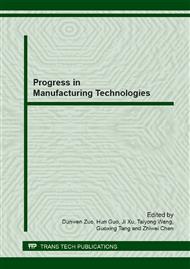[1]
C.K. Toh. Cutter path strategies in high speed rough milling of hardened steel. Materials and Design, 27(2006)107 – 114.
DOI: 10.1016/j.matdes.2004.09.021
Google Scholar
[2]
L.C. Chuang, H.T. Yong, Integrated rough machining methodology for centrifugal impeller manufacturing, International Journal of Advanced Manufacturing Technology, 34(2007)1062 -1071.
DOI: 10.1007/s00170-006-0675-3
Google Scholar
[3]
B. Lauiwers, P.P. Lefebvre. Five-axis rough milling strategies for complex shaped cavities based on morphing technology. Annals of CIRP, 55(2006)59 -62.
DOI: 10.1016/s0007-8506(07)60366-7
Google Scholar
[4]
J. Ajay, W.F. Yuen, and Y.S. Lee. Greedy tool heuristic approach to rough milling of complex shaped pockets. IIE Transaction, 35(2003)953–963.
DOI: 10.1080/07408170309342347
Google Scholar
[5]
S. Tao and K. -L. Ting, Unified rough cutting tool path generation for sculptured surface machining. International Journal of Production Research, 39(2001) 2973-2989.
DOI: 10.1080/00207540110052553
Google Scholar
[6]
S. H. F. Chuang and I. Z. Wang, Multipatched B-Spline Surfaces and Automatic Rough Cut Path Generation, International Journal of Advanced Manufacturing Technology, 16(2000)100–106.
DOI: 10.1007/s001700050014
Google Scholar
[7]
Vafaeesefat and H. A. E. Maraghy, Rough pocketing of multi-sculptured surface cavities, Proc Instn Mech Engrs Part B, 215(2001)745 – 753.
DOI: 10.1243/0954405011518638
Google Scholar
[8]
Y.S. Lee and Bahattin Koc, Ellipse-offset approach and inclined zig-zag method for multi-axis roughing of ruled surface pockets, Computer-Aided Design, 30(1998)957–971.
DOI: 10.1016/s0010-4485(98)00051-7
Google Scholar
[9]
D.M. Tsay, C. W Chen, G. Student, Improving rough cutting efficiency for machining of impellers, Proceedings of the ASME Turbo Expo, 4(2004)837-844.
DOI: 10.1115/gt2004-54025
Google Scholar
[10]
P. Pal, Remaining stock computation for 3D-machining in parametric regime, Journal of Manufacturing Science And Engineering, Transactions of the ASME, 127 (2005) 801-809.
DOI: 10.1115/1.2034510
Google Scholar
[11]
S. Ding, M. A. Manan, A. N. Poo , D.C. H. Yang and Z. Han Adaptive iso-planar tool path generation for machining of free-form surfaces , Computer Aided Design, 35 (2003)141-153.
DOI: 10.1016/s0010-4485(02)00048-9
Google Scholar
[12]
K. Suresh, D.C.H. Yang, Constant scallop-height machining of free-form surfaces, ASME Journal of Engineering for Industry. 116(1994)253-259.
DOI: 10.1115/1.2901938
Google Scholar
[13]
J.S. Chen, Y.K. Huang and M.S. Chen. A study of the surface scallop generating mechanism in the ball-end milling process. International Journal of Machine Tools & Manufacture, 45(2005) 1077–1084.
DOI: 10.1016/j.ijmachtools.2004.11.019
Google Scholar


